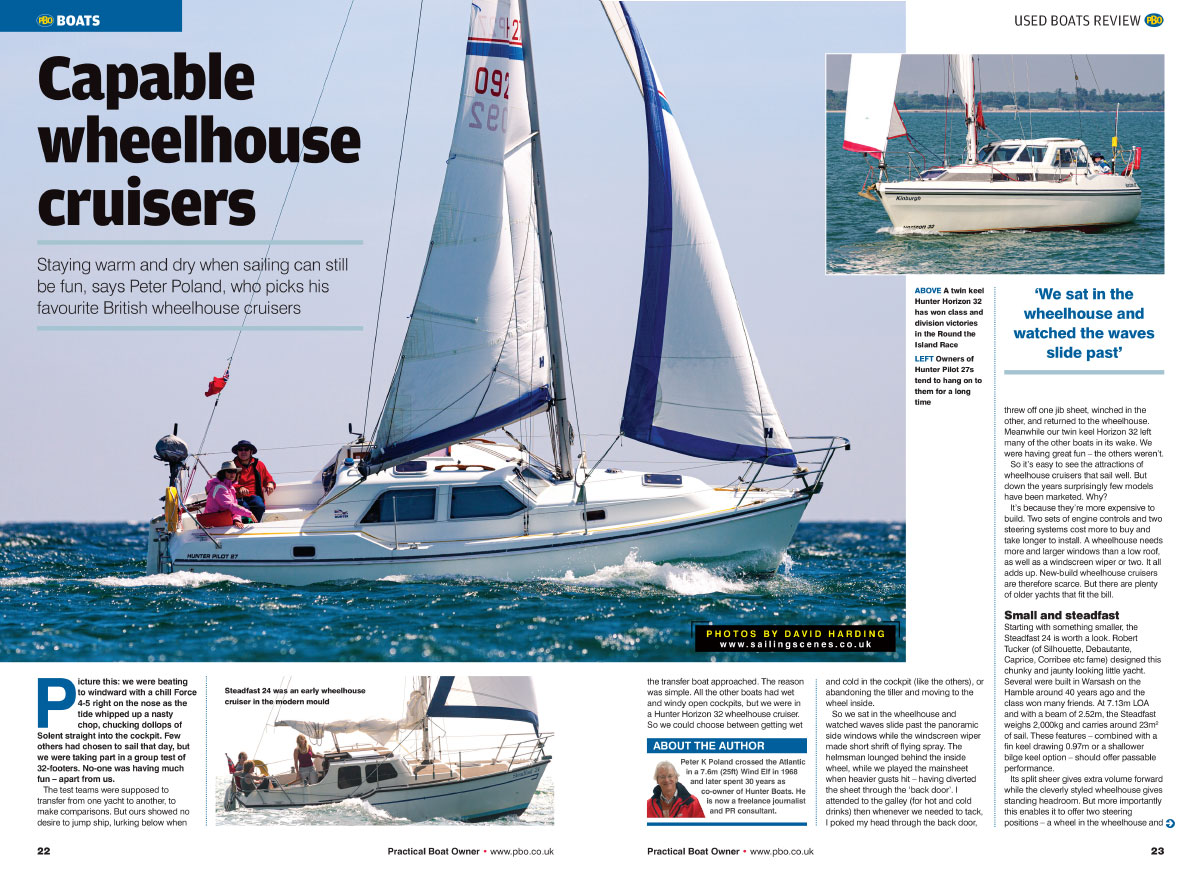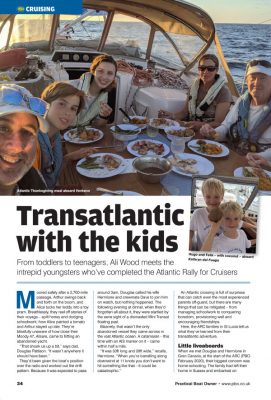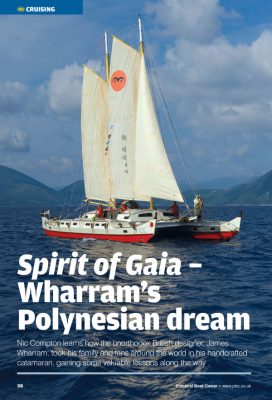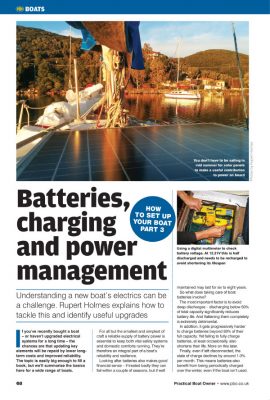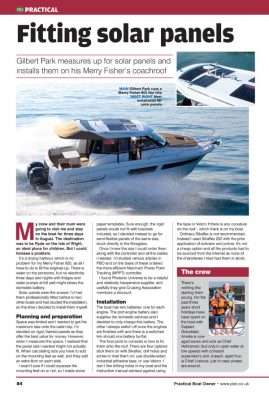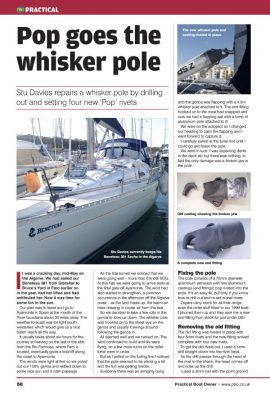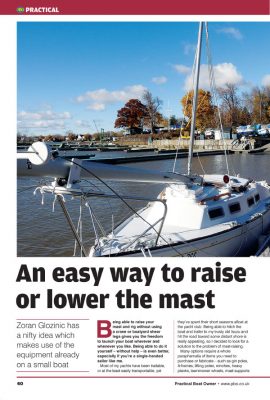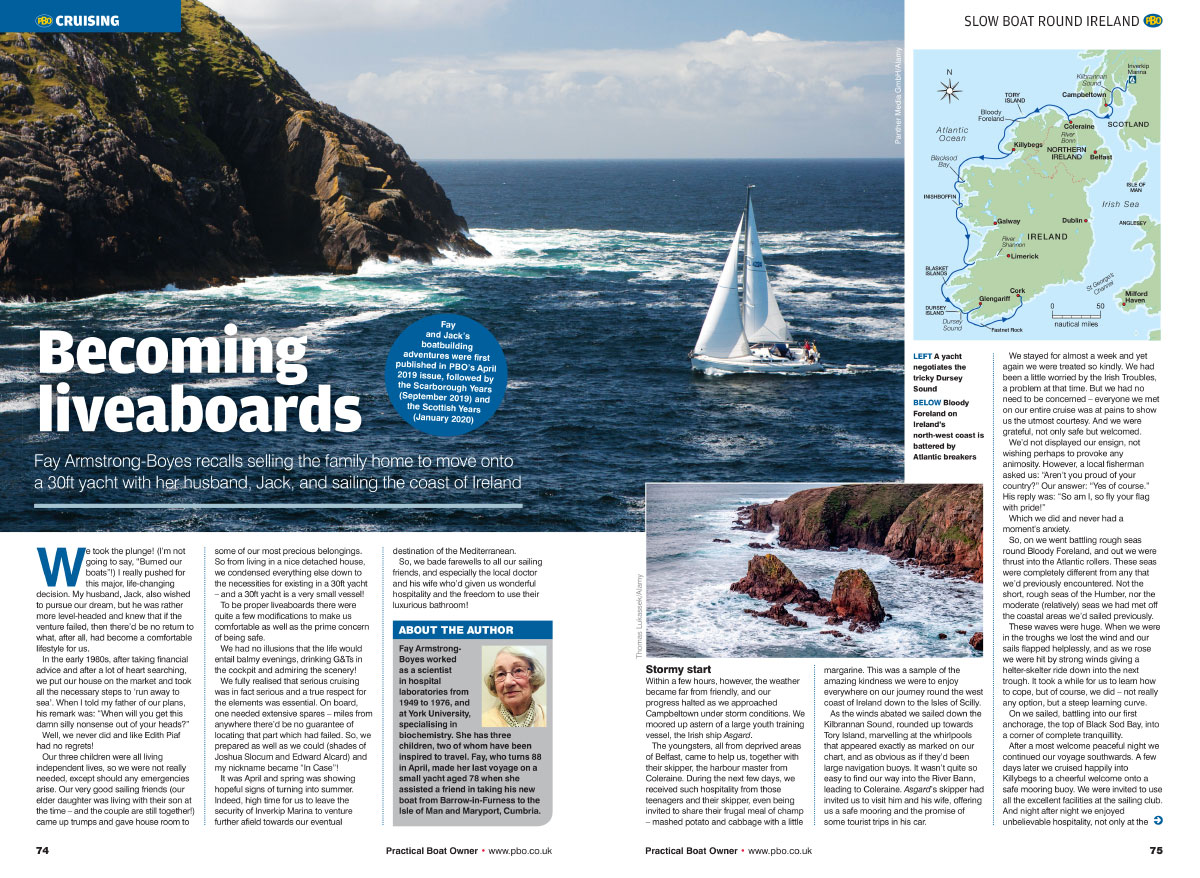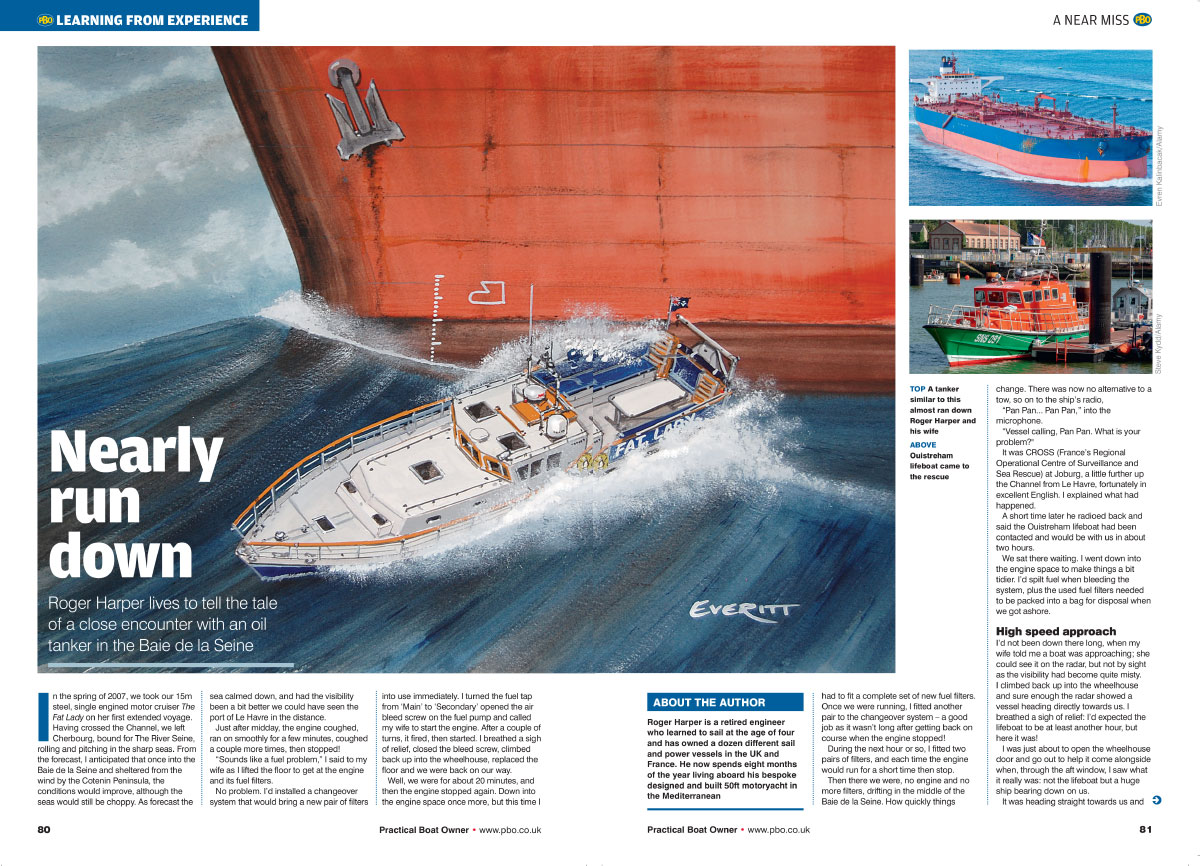
Pick up a copy of the April issue of PBO (on sale 20 Feb) and see for yourself why everyone is raving about the Coast 250 from Swallow Boats – a power-sailer extraordinaire – the boat that sails like a dream but has a 70hp tucked under the cockpit to get the hull planing along at 15 knots! Plus, we talk to multihull designer James Wharram about his 62-footer Spirit of Gaia and loads of DIY projects: up-close with the rivet gun, how to install solar panels and how to repair a wind turbine and two types of windlass.
To read a free preview of all the main articles below – just click on the image
Subscribe now to get every issue delivered to your door: www.magazinesdirect.com
 Used boat review: wheelhouse cruisers
Used boat review: wheelhouse cruisers
Staying warm and dry in a wheelhouse cruiser can still mean plenty of sailing fun
“Picture this: we were beating to windward with a chill Force 4-5 right on the nose as the tide whipped up a nasty chop, chucking dollops of Solent straight into the cockpit. Few others had chosen to sail that day, but we were taking part in a group test of 32-footers. No-one was having much fun – apart from us.
“The test teams were supposed to transfer from one yacht to another, to make comparisons. But ours showed no desire to jump ship, lurking below when the transfer boat approached. The reason was simple. All the other boats had wet and windy open cockpits, but we were in a Hunter Horizon 32 wheelhouse cruiser. So we could choose between getting wet and cold in the cockpit (like the others), or abandoning the tiller and moving to the wheel inside….” Read more…
 Coast 250 on test: power to the sailer
Coast 250 on test: power to the sailer
The Coast 250 is a planing power-sailer like none we’ve seen before
“Imagine this for a morning on the water. You start by motoring down the river at 15 knots. There’s no speed restriction and you want to get out to sea – for a sail. Once clear of the river, you find a brisk south-westerly kicking up a steep chop over the bar, so you throttle back to 10 knots and punch your way through it. Then you speed back up to 12 knots as you skim across the waves in the bay.
“In open water further offshore, you turn off the engine. Your boat sails better than many dedicated sailing boats of similar size that would be lucky to motor at 6 knots. They would still be on the way down the river or bouncing over the bar, probably drenching you in spray or green water, while you’re having a lovely sail… Does this sound far-fetched?” Read more…
 Transatlantic with the kids
Transatlantic with the kids
From toddlers to teenagers, we meet the intrepid youngsters who’ve sailed the Atlantic Rally for Cruisers
Moored safely after a 2,700-mile passage, Arthur swings back and forth on the boom, and Alice tucks her teddy into a toy pram. Breathlessly, they reel off stories of their voyage – spilt honey and dodging schoolwork; how Alice painted a tomato and Arthur stayed up late. They’re blissfully unaware of how close their Moody 47, Alisara, came to hitting an abandoned yacht.
“That shook us up a bit,” says dad, Douglas Pattison. “It wasn’t anywhere it should have been.” Read more…
 Polynesian dream
Polynesian dream
British designer James Wharram took his family around the world in a Polynesian-inspired catamaran
“The morning breeze was just starting to fill in as we headed out of Port Vathi on board Ionian Spirit, an old Danish fishing boat converted for charter. As we headed north, dramatic clouds piled up on the mountains of Ithaca, re-evoking the spirit of Odysseus, the island’s most famous citizen, and creating an unforgettable scene.
“Then a sail appeared on the bay ahead, and I was half-expecting to find a Greek trireme re-enacting the ancient story. Instead, we came across another kind of ancient craft: a Polynesian double-canoe of the type that sailed the Pacific at about the same time as Odysseus sailed the Ionian. Or, to be exact, British designer James Wharram’s interpretation of such a craft, the 63ft Spirit of Gaia, sailing once again after a five-year restoration.” Read more…
 Power management
Power management
Understanding a new boat’s electrics can be a challenge. Rupert Holmes explains how to tackle it
“If you’ve recently bought a boat – or haven’t upgraded electrical systems for a long time – the chances are that updating key elements will be repaid by lower long-term costs and improved reliability. The topic is easily big enough to fill a book, but we’ll summarise the basics here for a wide range of boats.
“For all but the smallest and simplest of craft a reliable supply of battery power is essential to keep both vital safety systems and domestic comforts running. They’re therefore an integral part of a boat’s reliability and resilience.” Read more…
 DIY Project: Fitting solar panels
DIY Project: Fitting solar panels
How a reader installed solar panels on the coachroof of his motor cruiser
My crew and their mum were going to visit me and stay on the boat for three days in August. The destination was to be Ryde on the Isle of Wight, an ideal place for children. But I could foresee a problem.
It’s a drying harbour, which is no problem for my Merry Fisher 855, as all I have to do is tilt the engines up. There is water on the pontoons, but no electricity: three days and nights with fridges and water pumps at full pelt might stress the domestic battery.
Solar panels were the answer. I’d had them professionally fitted before to two other boats and had studied the installation, so this time I decided to install them myself.
 DIY Project: Repairing with rivets
DIY Project: Repairing with rivets
Replacing a broken whisker pole end by drilling out and installing new Pop rivets
It was a cracking day, mid-May on the Algarve. We had sailed our Beneteau 381 from Gibraltar to Bruce’s Yard in Faro earlier on in the year, had her lifted and had antifouled her. Now it was time for some fun in the sun.
Our plan was to leave and go to Ayamonte in Spain at the mouth of the River Guadiana about 30 miles away. The weather forecast was for light south-westerlies which would give us a nice beam reach all the way.
It usually takes about six hours for the journey so leaving on the last of the ebb from the Rio Formosa, where Faro is located, eventually gives a tidal lift along the coast to Ayamonte.
The winds were light at first so we poled out our 150% genoa and settled down to some nice sun and a calm passage.
 DIY Project: Designing a system for raising a mast
DIY Project: Designing a system for raising a mast
Utilising a small yacht’s existing fittings to easily raise or lower a deck-stepped mast
Being able to raise your mast and rig without using a crane or boatyard shear legs gives you the freedom to launch your boat wherever and whenever you like. Being able to do it yourself – without help – is even better, especially if you’re a single-handed sailor like me.
Most of my yachts have been trailable, or at the least easily transportable, yet they’ve spent their short seasons afloat at the yacht club. Being able to hitch the boat and trailer to my trusty old Isuzu and hit the road toward some distant shore is really appealing, so I decided to look for a solution to the problem of mast-raising.
 DIY: Wind generator repair
DIY: Wind generator repair
Roger Hughes revives his venerable wind generator after it seizes in a hurricane
I confess, I’m frequently guilty of surrendering to the old adage, ‘If it ain’t broke, don’t fix it!’ But I got caught out in hurricane Dorian in October last year. Scheduled maintenance is one thing, but shinning up a 17m (57ft) mast just because a hurricane is expected is another.
However, my laziness meant I consequently had to dismantle and restore my Kiss wind generator – though I also installed a few slight improvements at the time to make regular maintenance easier in the future.
 Cruising adventure: Cuba and beyond
Cruising adventure: Cuba and beyond
How a young, inexperienced couple speedily refurbished a project boat and then sailed it to Cuba
When I first saw 40 Mile, a 34ft yacht covered stem to stern in green and black mildew, I thought she’d been abandoned. Her iron keel was rusty and the hull/keel fairing was so cracked it scared me to look at it. So when the new owners Eddy Ruffin and Taylor Henschel told me of their plans to sail across the Caribbean Sea, I was astonished. She was the worst-looking boat in the yard; the bottom paint was peeling off in spots, leaving the hull looking like the surface of the moon… it would take months, possibly years, to get her into shape.
But, being in the midst of the difficult renovation of our 38ft Ericson yacht, Walden I was ecstatic at the prospect of having neighbours with a similar project. Together, we shared the goal of leaving that dusty gravel boatyard to go cruising!
While we worked side-by-side on our boats, Eddy told me how the idea had come about…
 Cruising: Becoming liveaboards
Cruising: Becoming liveaboards
Living the dream in the 1980s… Fay Armstrong-Boyes and her husband sold their house and went cruising
We took the plunge! (I’m not going to say, “Burned our boats”!) I really pushed for this major, life-changing decision. My husband, Jack, also wished to pursue our dream, but he was rather more level-headed and knew that if the venture failed, then there’d be no return to what, after all, had become a comfortable lifestyle for us.
In the early 1980s, after taking financial advice and after a lot of heart searching, we put our house on the market and took all the necessary steps to ‘run away to sea’. When I told my father of our plans, his remark was: “When will you get this damn silly nonsense out of your heads?”
 Real-life survival: Nearly run down
Real-life survival: Nearly run down
Engineless and drifting, a reader lives to tell the tale of a close encounter with an oil tanker
In the spring of 2007, we took our 15m steel, single engined motor cruiser The Fat Lady on her first extended voyage. Having crossed the Channel, we left Cherbourg, bound for The River Seine, rolling and pitching in the sharp seas.
From the forecast, I anticipated that once into the Baie de la Seine and sheltered from the wind by the Cotenin Peninsula, the conditions would improve, although the seas would still be choppy. As forecast the sea calmed down, and had the visibility been a bit better we could have seen the port of Le Havre in the distance.
Just after midday, the engine coughed, ran on smoothly for a few minutes, coughed a couple more times, then stopped!
DIY Manual windlass fix
How a second-hand windlass off eBay was stripped down and rebuilt
DIY Electric windlass refit
An erratic electric windlass proved fairly simple to repair




